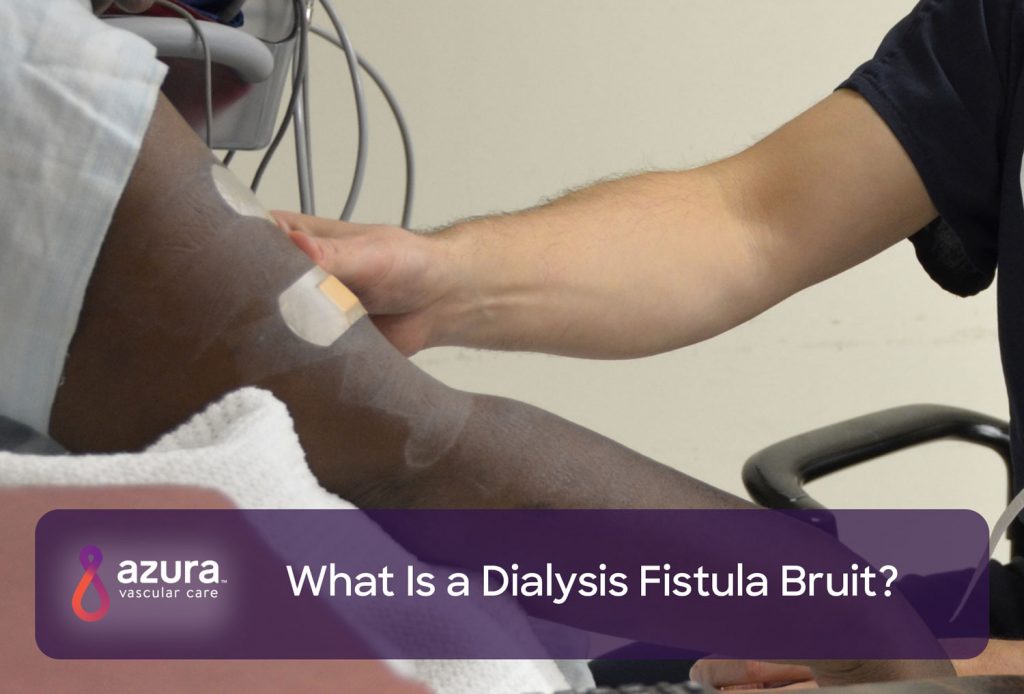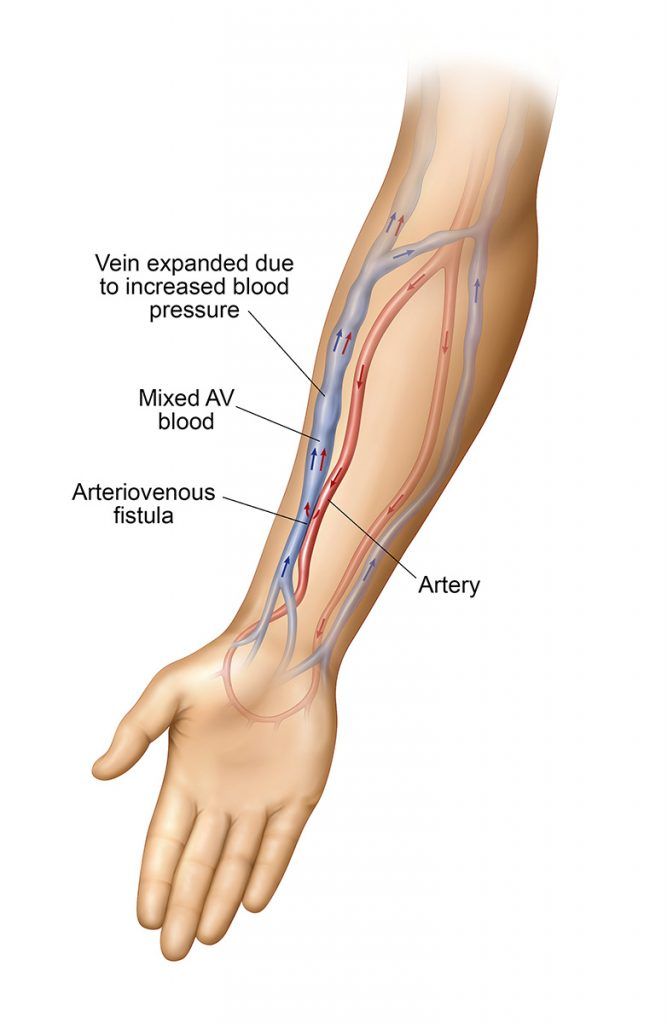
A dialysis fistula bruit (pronounced broo-ee), also called a vascular murmur, is an important sound and indicator of how well your dialysis access is functioning.
Hemodialysis requires access to your blood vessels. An arteriovenous fistula or AV fistula is one access type that is created by connecting an artery to a vein under the skin, usually in the upper or lower arm. (i) The high blood flow from the artery through the vein allows the fistula to grow larger and stronger. A healthy AV fistula has:
- A bruit (a rumbling sound that you can hear)
- A thrill (a rumbling sensation that you can feel)
- Good blood flow rate
Why the Fistula Bruit Is Important

The rumbling or swooshing sound of a dialysis fistula bruit is caused by the high-pressure flow of blood through the fistula. Although the bruit is usually heard with a stethoscope, it also can be felt on the overlying skin as a vibration, also referred to as a thrill. An easy way to remember the difference is “hear a bruit, feel a thrill.” Large amounts of blood move through AV fistulas at a rapid pace from high-pressure arteries into low-pressure veins, creating a constant murmur.
Small vessels or other medical conditions may make it difficult for some people to have a successful fistula, so it’s important to check your progress. One of the most common issues patients with a dialysis fistula develop is stenosis or narrowing of the veins and/or artery. (ii) Changes in the bruit or thrill at the fistula site may indicate stenosis. If you do not feel the thrill or hear the bruit in your access, call your doctor or the dialysis center immediately.
How to Find Your Fistula Bruit
Use sound and touch to check the blood flow through your fistula daily. When you place your ear or fingers over your fistula, you should be able to hear a consistent swoosh or feel a slight vibration.
The sound you hear may change from a swooshing noise to a whistle-like sound. Any change in the pitch may indicate a clot or a narrowing of the fistula. The changes will be more significant in cases with more narrowing. (ii)
Changes in the fistula bruit may signal a serious issue with your dialysis fistula, so be sure to monitor it daily and report any changes to your doctor as soon as you notice them. Over time, blockages in the vein may reduce blood drainage or the flow of blood from your artery into the fistula, or your fistula may become fully blocked with blood clots.
Your doctor may refer you to a vascular specialist such as an interventional radiologist, interventional nephrologist or vascular surgeon. Your vascular specialist may perform angiography to better understand why your fistula isn’t functioning properly. An angiogram is a procedure (using X-rays taken during the injection of a contrast dye) that allows visualization of the interior of blood vessels which helps in detecting narrowing or blockages. The procedure provides information that helps your vascular specialist determine your best treatment options. Often, the issue can be fixed quickly with percutaneous (through the skin) treatment as opposed to surgical repair. (iii)
In addition to changes in the thrill or bruit at your fistula site, also look for:
- Swelling or pain in your arm. (iii)
- Numbness in your hand. (iii)
- Lower hand temperature. (iii)
- Pain in the hand. (iv)
- Prolonged bleeding during or after needle insertion. (iv)
- Fluid leakage. (iv)
- Redness. (iv)
- A distended fistula. When your arm is elevated, the fistula should collapse and appear flat. When there is a stenosis, the fistula may not collapse. (iv)
For more information, call 866.996.9729 to schedule an appointment with a vascular specialist.
Sources:
(i) Fresenius Kidney Care. Hemodialysis Access: Your Lifeline for Treatment. Retrieved October 8, 2014, from https://www.freseniuskidneycare.com/ckd-treatment/in-center-hemodialysis/hemodialysis-access-options.
(ii) Healio Nephrology News & Issues. (n.d.). Monitoring and surveillance of the hemodialysis vascular access. Retrieved September 25, 2018, from https://www.healio.com/nephrology/vascular-access/news/online/{aee5b9d3-cd53-4674-ab6f-ab64aad30b9c}/monitoring-and-surveillance-of-the-hemodialysis-vascular-access
(iii) University of Washington Medicine. (n.d.). Angiography: Percutaneous dialysis fistula or graft treatment. Retrieved September 25, 2018, from https://www.uwmedicine.org/health-library/Pages/percutaneous-dialysis-fistula-graft.aspx
(iv) Koirala, N., Anvari, E., & McLennan, G. (2016). Monitoring and surveillance of hemodialysis access. Seminars in Interventional Radiology, 33(1), 25–30. http://doi.org/10.1055/s-0036-1572548


